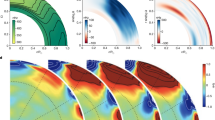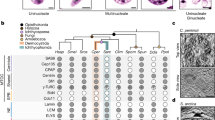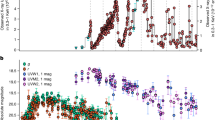Abstract
The bright compact radio source PKS1345+125 (4C 12.50) has been optically identified with a magnitude 17 galaxy with a redshift z=0.122 (refs 1, 2) and an unusual spectrum3. Here we show it to be an elliptical galaxy with a compact radio source coincident with its optically undistinguished nucleus. An unresolved radio-quiet Seyfert nucleus with the same redshift as the elliptical galaxy is offset by 1.8 arc s from the radio source. The Seyfert nucleus is remarkable for its location in an elliptical galaxy, for its extreme far-infrared flux, and for the very low density in the broad-line region. We present a model of 1345+125 involving the dynamical merger of an elliptical galaxy with a spiral. The merger has stripped the spiral galaxy of its interstellar gas, fuelling the nuclear engines in both galaxies, and allowing the broad-line region to stream out freely. The elliptical has acquired an envelope, and is becoming a radio-loud cD galaxy.
This is a preview of subscription content, access via your institution
Access options
Subscribe to this journal
Receive 51 print issues and online access
$199.00 per year
only $3.90 per issue
Buy this article
- Purchase on Springer Link
- Instant access to full article PDF
Prices may be subject to local taxes which are calculated during checkout
Similar content being viewed by others
References
Clarke, M. E., Bolton, J. G. & Shimmins, A. J. Aust. J. Phys. 19, 375–387 (1966).
Burbidge, E. M. Astrophys. J. 160, L33–L39 (1970).
Grandi, S. A. Astrophys. J. 215, 446–451 (1977).
McAdam, W. B. Proc. astr. Soc. Aust. 3, 283–285 (1978).
Fanti, C. et al. Astr. Astrophys. Suppl. Ser. 45, 61–75 (1981).
Dennison, B. & Condon, J. J. Astrophys. J 246, 91–99 (1981).
Perley, R. A. Astr. J. 87, 859–880 (1982).
IRAS Point Source Catalogue (Jet Propulsion Laboratory, Pasadena, 1985).
Baldwin, J. A., Phillips, M. M. & Terlevich, R. Publ. astr. Soc. Pacif. 93, 5–19 (1981).
Osterbrock, D. E. Astrophysics of Gaseous Nebulae, pp. 97–133 (Freeman, San Francisco, 1974).
Davidson, K. & Netzer, H. Rev. mod. Phys. 51, 715–766 (1979).
Heckman, T. M., Miley, G. K., van Bruegel, W. J. M. & Butcher, H. R. Astrophys. J. 247, 403–418 (1981).
Silk, J. & Norman, C. Astrophys. J. 247, 59–76 (1981).
Norman, C. & Silk, J. Astrophys. J. 266, 502–515 (1983).
Rees, M. J., Begelman, M. C., Blandford, R. D. & Phinney, E. S. Nature 295, 17–21 (1982).
Author information
Authors and Affiliations
Rights and permissions
About this article
Cite this article
Gilmore, G., Shaw, M. PKS1345+125:a Seyfert nucleus merging with a powerful radio galaxy. Nature 321, 750–753 (1986). https://doi.org/10.1038/321750a0
Received:
Accepted:
Issue Date:
DOI: https://doi.org/10.1038/321750a0
Comments
By submitting a comment you agree to abide by our Terms and Community Guidelines. If you find something abusive or that does not comply with our terms or guidelines please flag it as inappropriate.



